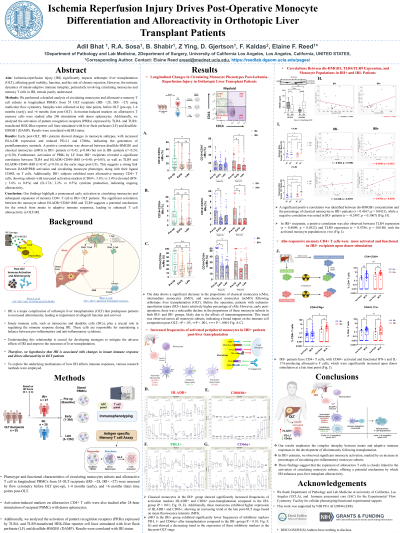Back

Ischemia Reperfusion Injury Drives Post-Operative Monocyte Differentiation and Alloreactivity in Orthotopic Liver Transplant Patients
(P208) Ischemia reperfusion injury drives post-operative monocyte differentiation and alloreactivity in orthotopic liver transplant patients
Location: Platinum Ballroom

Poster Presenter(s)
Aim: Ischemia-reperfusion injury (IRI) significantly impacts orthotopic liver transplantation (OLT), affecting graft viability, function, and the risk of chronic rejection. However, the intricate dynamics of innate-adaptive immune interplay, particularly involving circulating monocytes and memory T cells in IRI, remain poorly understood.
Method: We performed a detailed analysis of circulating monocytes and alloreactive memory T cell subsets in longitudinal PBMCs from 55 OLT recipients (IRI- =28, IRI+ =27) using multicolor flow cytometry. Samples were collected at key time points, before OLT (pre-op), 1-3 months (early), and >6 months (late post-OLT). Activation-induced markers on alloreactive T memory cells were studied after 24h stimulation with donor splenocytes. Additionally, we analyzed the activation of pattern recognition receptors (PRRs) expressed by TLR4- and TLR9-transfected HEK-Blue reporter cell lines stimulated with liver flush perfusate (LF) and disulfide-HMGB1 (DAMP). Results were correlated with IRI status.
Results: Early post-OLT, IRI+ patients showed changes in monocyte subtypes, with increased HLA-DR expression and reduced PD-L1 and CD66a, indicating the generation of proinflammatory sentinels. A positive correlation was observed between disulfide-HMGB1 and classical monocytes (cMO) in IRI+ patients (r=0.43; p=0.04) but not in IRI- patients (r=-0.24; p=0.30). Furthermore, activation of PRRs by LF from IRI+ recipients revealed a significant correlation between TLR4 and HLADR+CD40+iMO (r=0.40; p=0.05), as well as TLR9 and HLADR+CD40+iMO (r=0.47; p=0.01) at the early stage post-LTx. This suggests a strong link between DAMP/PRR activation and circulating monocyte phenotype, along with their ligand CD40L on T cells. Additionally, IRI+ subjects exhibited more alloreactive memory CD4+ T cells, showing subsets with increased activation markers (CD69+; 5.6% vs 3.4%) elevated (IFN-γ 3.6% vs 0.8%) and (IL-17A; 2.2% vs 0.5%) cytokine production, indicating ongoing alloreactivity.
Conclusion: Our findings highlight a pronounced early activation in circulating monocytes and subsequent expansion of memory CD4+ T cell in IRI+ OLT patients. The significant correlation between the monocyte subset HLADR+CD40+iMO and TLR9 suggests a potential mechanism for the switch from innate to adaptive immune responses, leading to enhanced T cell alloreactivity in OLT-IRI.
Method: We performed a detailed analysis of circulating monocytes and alloreactive memory T cell subsets in longitudinal PBMCs from 55 OLT recipients (IRI- =28, IRI+ =27) using multicolor flow cytometry. Samples were collected at key time points, before OLT (pre-op), 1-3 months (early), and >6 months (late post-OLT). Activation-induced markers on alloreactive T memory cells were studied after 24h stimulation with donor splenocytes. Additionally, we analyzed the activation of pattern recognition receptors (PRRs) expressed by TLR4- and TLR9-transfected HEK-Blue reporter cell lines stimulated with liver flush perfusate (LF) and disulfide-HMGB1 (DAMP). Results were correlated with IRI status.
Results: Early post-OLT, IRI+ patients showed changes in monocyte subtypes, with increased HLA-DR expression and reduced PD-L1 and CD66a, indicating the generation of proinflammatory sentinels. A positive correlation was observed between disulfide-HMGB1 and classical monocytes (cMO) in IRI+ patients (r=0.43; p=0.04) but not in IRI- patients (r=-0.24; p=0.30). Furthermore, activation of PRRs by LF from IRI+ recipients revealed a significant correlation between TLR4 and HLADR+CD40+iMO (r=0.40; p=0.05), as well as TLR9 and HLADR+CD40+iMO (r=0.47; p=0.01) at the early stage post-LTx. This suggests a strong link between DAMP/PRR activation and circulating monocyte phenotype, along with their ligand CD40L on T cells. Additionally, IRI+ subjects exhibited more alloreactive memory CD4+ T cells, showing subsets with increased activation markers (CD69+; 5.6% vs 3.4%) elevated (IFN-γ 3.6% vs 0.8%) and (IL-17A; 2.2% vs 0.5%) cytokine production, indicating ongoing alloreactivity.
Conclusion: Our findings highlight a pronounced early activation in circulating monocytes and subsequent expansion of memory CD4+ T cell in IRI+ OLT patients. The significant correlation between the monocyte subset HLADR+CD40+iMO and TLR9 suggests a potential mechanism for the switch from innate to adaptive immune responses, leading to enhanced T cell alloreactivity in OLT-IRI.

